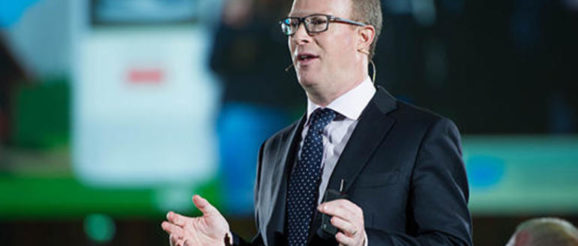Salesforce’s chief innovation officer shares a playbook for leading during uncertainty | ZDNet

This TechRepublic Premium ebook compiles the latest on cancelled conferences, cybersecurity attacks, remote work tips, and the impact this pandemic is having on the tech industry.
The COVID-19 pandemic continues to impact industries and lives around the world, with unemployment in the US reaching record levels and millions of businesses closing, temporarily or permanently. While there is an enormous amount of economic uncertainty ahead, one thing is clear: There’s no going back to the way things were.
As organizations begin the process of reopening, they’ll need new ways of planning, managing, and monitoring workforce readiness, facilities preparedness, and emergency management response. They’ll need strong collaboration across departments, tools to make data-driven decisions quickly, and the ability to communicate to employees, partners, and customers at scale.
To help companies manage teams and businesses through these changing environments, Salesforce is launching Work.com — new technology solutions and resources to help businesses and community leaders around the world to reopen safely, re-skill employees, and respond efficiently on the heels of the COVID-19 pandemic.
Simon Mulcahy, chief innovation officer at Salesforce.
I sat down with Salesforce‘s Chief Innovation Officer, Simon Mulcahy, to discuss the industry trends he’s seeing as well as key takeaways from Salesforce’s new COVID-19 Response Playbook, which provides leaders with a framework for planning, prioritizing, and orchestrating efforts as the crisis unfolds.
Vala Afshar: In your role, how are you helping customers adapt to this changing world?
Simon Mulcahy: Most companies have a “renovate” mindset where they port new technology over old assumptions or ways of thinking, which yields improvement but not a complete transformation. My job is to help companies reinvent their established processes by pausing and re-examining their approach to technology adoption. By flipping the process on its head and starting with the objective — the “job to be done” — we can reverse engineer how they get there through leveraging technology. Digital transformation was already a CEO imperative, but COVID-19 has absolutely accelerated it.
VA: Many organizations have been in a kind of fight-or-flight mode. What’s the path to getting past this?
SM: We think about this crisis in three distinct phases: the crisis response; reopening; and the next normal with a renewed focus on growth.
The first step is to stabilize operations and buffer against short-term risks. We recommend setting up a dedicated crisis response leadership team to define options, risks, and courses of action. Then execute based on your top priorities. Taking care of employees and customers should be first on the list. Leadership is critical here — delivered with transparency, authenticity, and optimism. At Salesforce, we are delivering access and analysis of trusted COVID-19 global data from our community of experts to all of our stakeholders using Tableau.
How businesses can structure their approach to the COVID-19 pandemic – stabilize, reopen and grow.
VA: For all companies, we have been intensely focusing on business stabilization for the past couple of months. What comes next?
SM: The second phase is safely reopening, which we’re beginning to enter now. I’m very proud to be part of a company that has quickly pivoted to help our customers manage through this unprecedented time with solutions like Salesforce Care and Work.com.
As companies start to plan and orchestrate reopening, they should concentrate on setting up processes that allow for effective communication and flexibility, including building a dedicated team and command center; scenario planning; activating employee wellness and training tools; and establishing feedback channels to deeply listen to customers’ and employees’ evolving needs.
And as the future comes into focus — and the next “new normal” is established — companies can shift toward a growth phase to emerge from the crisis more resilient and relevant than before.
VA: How can leaders ensure they’re making changes that will set them up for long-term success and not just temporary fixes?
SM: COVID-19 is more than a health and economic crisis, it’s a human one. The way companies take care of their stakeholders — employees, customers, and society at large — during this time is critical, and will have an enduring impact on trust.
There are four core capabilities to focus on. First, empower every level of the organization to make better, faster, data-driven decisions. Second, focus on how you work, including the physical and psychological safety of employees, stabilizing internal communications and productivity, and evolving new ways to get work done. Third, re-prioritize resources and redesign experiences to offer personalized engagement that is responsive to customers’ new needs. Finally, plan for how the business can serve society by doubling down on philanthropy, offering company resources to serve communities in need, and demonstrating civic leadership.
Within each pandemic playbook track — stabilize, reopen, and grow — business leaders must focus on decision making, how you work, customer engagement and serving society.
VA: Do you have any other wisdom to share with leaders on how to navigate this challenging time?
SM: Collectively, we should accept that we won’t be returning to the same “old normal” — digital agility will now be material for every business going forward. Those who embrace this fact early on can come out of this crisis even more productive, resilient, and closer to their customers. The pandemic has shown how unprepared many organizations were for an event like this, and we know it’s unlikely to be the last of its kind. Some decisions close doors, while others increase your options for reacting more effectively down the line. As Rahm Emanuel, President Obama’s Chief of Staff, famously said, “Never allow a good crisis to go to waste.”
